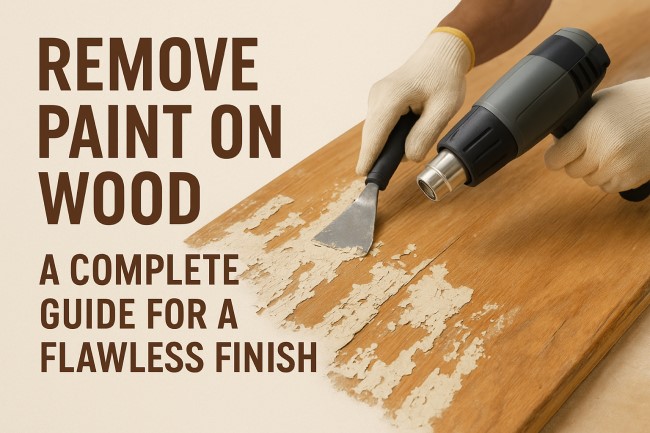Removing Paint on Wood: A Complete Guide for a Flawless Finish

When it comes to removing paint on wood, the goal is to restore the natural beauty of the material without damaging its surface. Whether it’s an antique chair, wooden floor, or outdoor deck, the right paint removal technique ensures a smooth, clean surface ready for refinishing. In this guide, we’ll explore the best methods, tools, and safety tips to achieve professional-quality results.
Understanding Paint Removal on Wood
Before you begin the paint removal on wood process, it’s important to understand the type of wood you’re working with and the layers of paint applied. Different woods—like oak, pine, or mahogany—react differently to heat, chemicals, and sanding. Also, older paints may contain lead, requiring extra caution.
Key factors to consider:
-
Wood type: Softwoods can scratch easily, while hardwoods are more durable.
-
Paint layers: Multiple coats may require repeated treatments.
-
Surface size: Large, flat areas may be easier to sand, while intricate carvings need chemical or gentle heat stripping.
Popular Methods to Remove Paint on Wood
There are several proven methods for paint removal on wood, each with its own benefits and best-use scenarios.
1. Chemical Paint Removers
Chemical paint removers are ideal for large surfaces or detailed woodwork. They break down paint layers so you can scrape them off without too much effort.
How to Use Paint Remover on Wood
-
Preparation: Place the wood in a well-ventilated area and wear gloves, eye protection, and a respirator.
-
Application: Apply the paint remover evenly using a brush.
-
Waiting Time: Let it sit for the time specified on the product instructions.
-
Removal: Use a scraper or putty knife to lift the softened paint.
-
Cleaning: Wipe down the surface with a damp cloth to remove residue.
Tip: Gel-based removers are great for vertical surfaces since they don’t drip as easily.
2. Heat Guns
A heat gun softens paint, allowing you to scrape it off easily. This method works best for flat surfaces and tough paint layers.
Advantages:
-
No chemicals involved.
-
Effective for stubborn paint.
Precautions:
-
Keep the heat gun moving to avoid scorching the wood.
-
Avoid overheating if there’s a chance of lead paint—lead fumes are hazardous.
3. Sanding
Sanding is a straightforward way to remove paint on wood, especially when the surface is flat and the paint is not deeply embedded in the grain.
Steps for Sanding:
-
Start with coarse grit sandpaper (80-100 grit) to strip paint.
-
Move to medium grit (120-150 grit) for smoothing.
-
Finish with fine grit (220 grit) for a polished surface.
Warning: Sanding removes wood layers along with paint, so proceed carefully.
4. Eco-Friendly Paint Removal Options
If you prefer non-toxic solutions, try soy-based or citrus-based paint removers. They work slower but are safer for indoor use and sensitive wood surfaces.
Step-by-Step Guide for Removing Paint on Wood
To achieve professional results, follow this structured process:
Step 1: Prepare the Area
-
Lay down drop cloths to protect floors.
-
Remove hardware from the wood surface.
-
Test a small, hidden area first.
Step 2: Choose Your Method
Select the method that best suits your wood type and project:
-
Chemical paint remover for intricate or curved designs.
-
Heat gun for thick layers on flat surfaces.
-
Sanding for quick work on smooth, flat boards.
Step 3: Apply the Chosen Technique
-
Follow the product instructions if using chemicals.
-
Keep tools clean and sharp for effective scraping.
Step 4: Clean and Neutralize
If you’ve used a chemical remover, neutralize the surface according to the product’s guidance. Residue left behind can affect new paint or stain adhesion.
Step 5: Final Sanding
Lightly sand the entire surface to create a smooth finish.
Step 6: Refinish the Wood
Once the paint is gone, you can apply a stain, sealant, or fresh coat of paint.
Safety Tips for Paint Removal on Wood
-
Wear Protective Gear: Gloves, goggles, and masks are essential.
-
Test for Lead: Especially in homes built before 1978.
-
Work in Ventilated Areas: This prevents inhalation of fumes or dust.
-
Handle Tools with Care: Heat guns and scrapers can cause injury if misused.
Common Mistakes to Avoid
-
Using too much force: Can gouge or scratch the wood.
-
Skipping preparation: Results in messy and uneven work.
-
Not removing residue: Can cause future paint or stain to peel.
Choosing the Right Paint Remover on Wood
When selecting a paint remover on wood, look for:
-
Low fumes for indoor projects.
-
Gel or paste consistency for vertical surfaces.
-
Eco-friendly options for safety and environmental benefits.
When to Hire a Professional
If the project involves valuable antiques, lead paint, or large surfaces, hiring an expert ensures safety and preserves the integrity of the wood.
Final Thoughts
Removing paint on wood is a rewarding project that brings out the material’s natural beauty. Whether you use chemical paint removers, heat guns, sanding, or eco-friendly options, the key is to work patiently and safely. By following the right steps and avoiding common mistakes, you can transform old, painted wood into a stunning surface ready for a fresh look.



